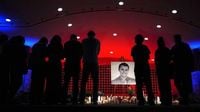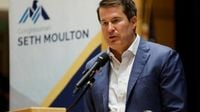On September 10, 2025, the United States was rocked by the assassination of Charlie Kirk, a prominent right-wing activist, during an event at Utah Valley University. Kirk, known for his outspoken views and his “American Comeback” tour, was shot in the neck by a single bullet while speaking to a crowd. He died shortly after being rushed to the hospital, leaving a nation already simmering with tension to grapple with the latest and perhaps most dramatic episode in the country’s recent history of political violence.
The suspect in Kirk’s killing, 22-year-old Tyler Robinson, was taken into custody after a family member recognized him in surveillance footage and urged him to turn himself in, according to The Utah Governor’s Office. Robinson, described by relatives as a “squeaky clean, considerate kid,” had previously been registered as an unaffiliated voter, though his parents are Republicans. This detail complicated the immediate narrative spun by some political figures, including President Donald Trump, who were quick to blame the political left for Kirk’s murder. As The National reported, Robinson’s background seemed far removed from that of a so-called radical leftist, challenging assumptions and fueling further debate about the roots and direction of political violence in America.
Charlie Kirk’s death has sent shockwaves through the nation’s political landscape, with reactions split sharply along partisan lines. Some commentators, as quoted in The National, have called it a “watershed moment,” a glaring symbol of the fears, bitterness, and division boiling over in today’s America. Stephen Marche, author of The Next Civil War: Dispatches from the American Future, observed, “the sense of collective mourning no longer applies.” Instead, he noted, social media was flooded with both celebration and blood-curdling threats of retribution, reflecting a country at odds with itself.
Massachusetts Representative Seth Moulton was among those who stepped forward to condemn the violence. Appearing on CNN, Moulton called on President Trump and Ohio Representative Warren Davidson to “be serious about where this violence is coming from.” He cited statistics from the Anti-Defamation League, stating that right-wing extremists are responsible for 76 percent of extremist killings, while left-wing extremists account for just 4 percent. “There are people who are trying to polarize us further, divide our nation further and just blame the left, even while those of us on the Democratic side, by and large, are saying we all need to turn down the rhetoric, so let’s be serious about where this violence is coming from,” Moulton said, according to CNN.
However, Moulton’s public stance came at a personal cost. After his appearance, he and his two young daughters were subjected to a torrent of violent and graphic threats, mostly from right-wing individuals. Voicemails and social media posts included explicit language and threats to his life and the safety of his family. One particularly chilling message stated, “I hope some good ol’ MAGA boy blows your motherf—ing brains out. I would spend the rest of my (expletive) life in federal prison to make America great again by eliminating somebody like you. I pray for your violent, bloody, anguishing death.”
Moulton, a Marine veteran who served four tours in Iraq, spoke candidly to NBC 10 Boston about the impact of these threats. “On a very personal level, I’ve got two little kids, and when you see those posts or if you go online and listen to the voicemails that I received not just threatening me but threatening my little girls, that’s literally my greatest fear.”
The assassination of Kirk and the subsequent wave of threats against public figures like Moulton have reignited debate over the trajectory of American politics. As The National noted, the United States has experienced previous spikes in political violence, particularly at the end of the 19th and into the 20th century, and again during the 1960s and 1970s. That era saw the assassinations of John and Robert Kennedy, Malcolm X, and Martin Luther King Jr., as well as attempts on the lives of other political figures. In more recent years, the tempo has quickened, with incidents such as the attempted assassination of Democratic Congresswoman Gabby Giffords in 2011, the shooting of Republican Congressman Steve Scalise in 2017, and the 2022 attack on Paul Pelosi, husband of then-Speaker Nancy Pelosi.
Mike Jensen, a researcher at the University of Maryland who tracks political violence, told Reuters that the U.S. experienced about 150 politically motivated attacks in the first half of 2025—nearly double the number from the same period the previous year. “I think we are in a very, very dangerous spot right now that could quite easily escalate into more widespread civil unrest if we don’t get a hold of it,” Jensen warned. “This could absolutely serve as a kind of flashpoint that inspires more of it.”
Surveys and studies cited by The New York Times and political scientists Nathan P. Kalmoe and Lilliana Mason reveal a disturbing normalization of political violence among the American public. Around 20 percent of respondents in a recent survey said that political violence was at least sometimes justified, and 60 percent said it was justified if the opposing party committed violence first—a figure that’s risen sharply over the past four years. Even more troubling, about 12 percent of Republicans and 11 percent of Democrats said it was justified for members of their party to kill opposing political leaders to advance their goals.
Experts point to a convergence of factors fueling this violence: economic insecurity, demographic changes, and an increasingly inflammatory tone in political discourse. Social media amplifies anger and conspiracy theories, turning policy disagreements into personal animosity. As The National observed, “Traditional ideological divides, they say, once centred on policy disagreements, have morphed into a deeper, more personal animosity.”
This climate has also led to a surge in so-called “preppers”—Americans actively preparing for civil unrest or even civil war. According to a 2024 analysis by FEMA, about 20 million Americans are now preparing for cataclysm, double the number from 2017. Fortitude Ranch, a network of survivalist retreats, reportedly has more than 1,000 members from across the political spectrum, all bracing for potential societal collapse.
Still, some see talk of civil war as alarmist. Others, like Stephen Marche, argue the threat is real and growing. “What the experts on civil war described to me was the steady encroachment of murder and intimidation from rhetoric, to political and legal institutions, to everyday life,” Marche wrote in The Independent after Kirk’s assassination. “The primary crisis in America... is whether the political system or straight murder will determine the future of the country. Once the fires of violence have been lit, they are almost impossible to dampen.”
As Kirk’s widow, Erika Kirk, vowed that her late husband’s mission would become “stronger, bolder, louder and greater than ever,” the nation remains on edge. The hope for a cooling-off period seems remote. Even the U.S. House of Representatives could not manage a moment of silence for Kirk without descending into a shouting match, a symbolic reminder of just how fraught America’s political climate has become. The days ahead appear perilous, with the threat that the response to Kirk’s assassination could further fracture the country very real indeed.






